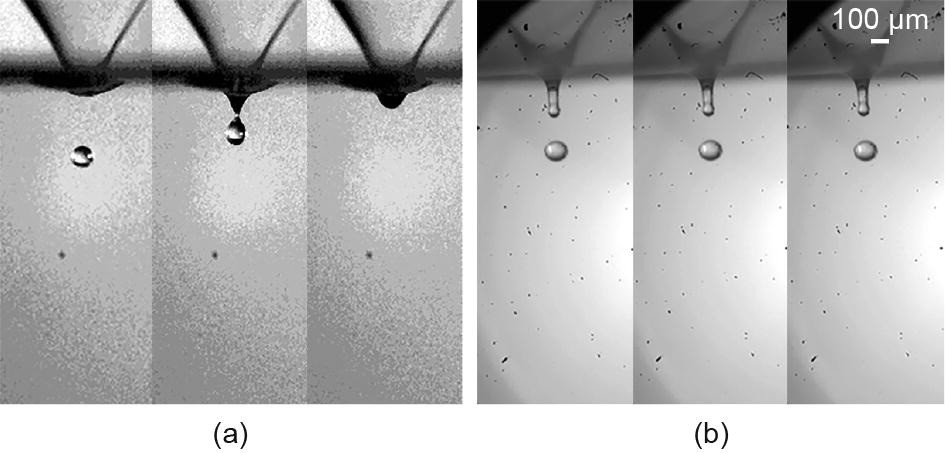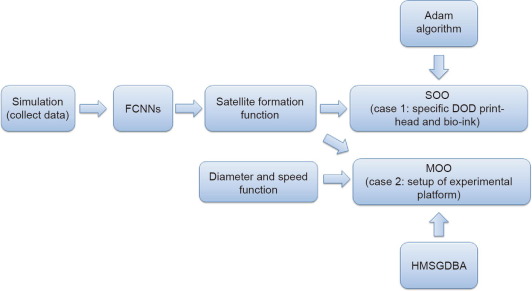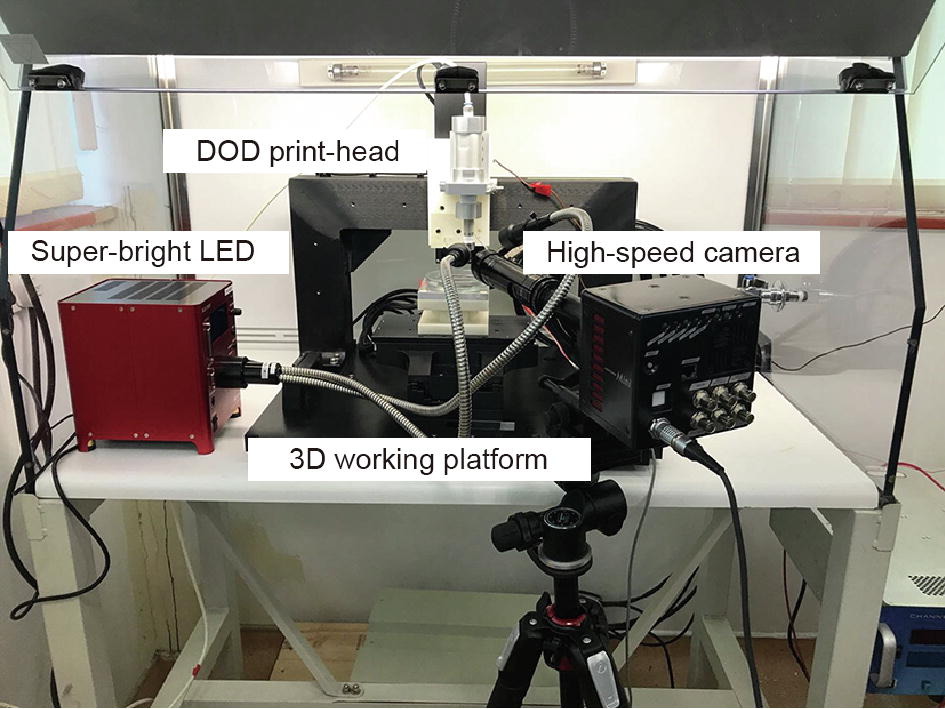As bioprinting continues to pick up steam in labs around the world, researchers still study the process intensively to build on current techniques and innovation. In ‘Multi-Objective Optimization Design through Machine Learning for Drop-on-Demand Bioprinting,’ authors Jia Shi, Jinchun Song, Bin Song, and Wen Lu explore the challenges in drop-on-demand (DOD) methods for printing cells.
While DOD bioprinting offers major advantages such as affordability and speed in production during tissue engineering, there are other significant challenges which have been difficult to overcome in the lab, such as satellite generation, and droplets that are either too large, or speed that is too low. Tissue engineering is an extremely intricate process and keeping cells alive can be a tremendous task, so any techniques that reduce stability or accuracy are often quickly dismissed. Here, the authors detail their new design method for DOD printing parameters: multi-objective optimization (MOO).
The MOO method allows for development of a satellite formation model with fully connected neural networks (FCNNs), but also creates smaller droplets extruded at higher speeds. Droplet characteristics can vary depending on printing parameters. Settings, types of ink, and print-head structures can have a negative effect on bioprinting if not used properly, and so far, few bioprinting setups have been able to offer all optimizations necessary for better results. Part of this is because improving one challenge often causes others:
“For example, increasing droplet speed can enhance printing stability, but generates satellites. Reducing satellites or droplet diameter can improve printing precision but may decrease droplet speed and printing stability. Thus, there is a need to find as good a solution as possible to balance these different goals through a multi-objective optimization (MOO) method,” state the researchers.
They began exploring machine learning as the solution to the complex issues in bioprinting, hopeful due to its effectiveness in so many other fields related to engineering. They created a schematic diagram for using MOO to work within piezoelectric DOD printing parameters.
A single-objective optimization and MOO problems were created so the research team could continue refining printing parameters. Fully connected neural networks (FCNNs) functioned to ‘identify’ the connection between satellites and printing parameters, with their simulation model taking in data. Ultimately, the team discovered that by printing one (smaller) droplet at a time they could speed up the whole process—and improve accuracy and stability.
Machine learning was used to map out what proved to be a complex model. The researchers customized a piezoelectric DOD print-head with a nozzle diameter of 100 μm and used a high-speed camera for capturing the printing process, as voltage was applied to trigger formation of the droplets. The following bioinks were used:
- HeLa cells
- Dulbecco’s Modified Eagle Medium (DMEM)
- Sodium alginate (SA)
“When increasing the concentration of SA to 1.0%, two cell concentrations, 1 ×106 and 0.5 × 106 mL–1, were initially used. The testing results showed that both had almost the same viscosity, while the one with 1 × 106 mL–1cells could not break into droplets after ejection,” stated the researchers. “A possible reason for this result is that the surface tension value of this bio-ink decreases during the transient process of generating droplets, which reduces the total free energy and increases the printing difficulty.
“Hence, cells with a concentration of 0.5 × 106 mL–1 were selected for the preparation of bio-ink C as listed in Table 3 in order to ensure that the printer was working well.”
For the SOO challenge, voltage was used in 3D printing ‘primary droplets’ for the bio-inks you see in Table 3. Bioinks A and B caused satellites to form, while the C bioink did not prompt droplets.
“All of the optimized voltages were able to generate only primary droplets when printed with the corresponding bio-ink, which verified the designed FCNNs and the SOO results.”
In optimization design of DOD printing parameters, the researchers learned that highly viscous bioinks do not produce the precision or ‘robust’ qualities necessary. The research team concluded as follows:
“The results showed that single droplets were stably printed after optimization in the SOO problem. In the MOO problem, the droplet speed was increased from 0.88 to 2.08 m·s−1 after optimization. Furthermore, based on the optimized nozzle diameter of the DOD print-head, a range of bio-ink properties was proposed as a reference for preparing bio-ink to obtain the best printing precision with a robust printing process.”
“The suggested bio-ink viscosity is from 1.00 to 2.60 cP, the surface tension is from 50.35 to 67.55 mN·m−1, and the corresponding voltage is from 22 to 40 V. The proposed method improves the printing precision and stability for precise order of cell arrays. Optimized results can be treated as a guideline for the setup of a piezoelectric DOD bioprinting experimental platform.”
3D printing offers infinite choices in design, production, and innovation—much of which was not possible before. Along with that, there are numerous other technologies which have branched off from 3D printing, such as 4D printing with objects and textures morphing as their environment changes. Bioprinting is another, already proving via many different types of devices and implants to be invaluable in changing the quality of life for patients, saving lives, and showing strong potential for the eventual fabrication of human organs in the lab.
Find out more about bioprinting and machine learning processes here. What do you think of this news? Let us know your thoughts! Join the discussion of this and other 3D printing topics at 3DPrintBoard.com.

Experimental validation of the proposed method. (a) Experimental results with the initial printing parameters of U = 33 V, μl = 5 cP, and σ = 71.00 mN·m−1; (b) experimental results with the optimized printing parameters of U = 20 V, μl = 1.07 cP, and σ = 41.5 mN·m−1.
Subscribe to Our Email Newsletter
Stay up-to-date on all the latest news from the 3D printing industry and receive information and offers from third party vendors.
Print Services
Upload your 3D Models and get them printed quickly and efficiently.
You May Also Like
3D Printing News Briefs, June 11, 2025: Sustainability, Automotive Tooling, & More
We’re starting with sustainability news in today’s 3D Printing News Briefs, as EOS has strengthened its commitment on climate responsibility, and Zestep is making 3D printing filament out of eyewear...
3D Printing 50 Polymer Stand-In Parts for Tokamaks at the PPPL & Elytt Energy
Of all the world’s things, a tokamak is one of the hardest, most complex, expensive and exacting ones to make. These fusion energy devices make plasma, and use magnets to...
3D Printing News Briefs, May 17, 2025: Color-Changing Materials, Humanoid Robot, & More
We’re covering research innovations in today’s 3D Printing News Briefs! First, Penn Engineering developed 3D printed materials that change color under stress, and UC Berkeley researchers created an open source,...
Firehawk Aerospace Partners with JuggerBot 3D, Gets $1.25M from AFWERX for 3D Printed Propellants
Texas-based Firehawk Aerospace, an advanced energetic materials firm that works with aerospace and defense applications, announced a strategic partnership with JuggerBot 3D, an Ohio-based large-format 3D printer manufacturer. Together, the...





































